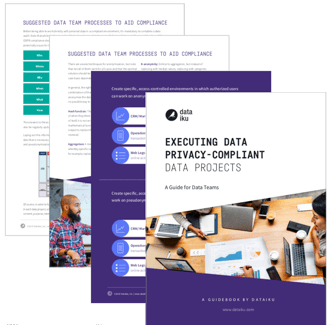The Credit Suisse Global Wealth report has been released, and while some serious efforts to fight inequalities still have to be made — 1% of the adults in the world are millionaires and hold 44% of the global wealth — this report also confirms the decrease in the gap between the richest and poorest started in 2016. It also indicates a quicker than anticipated number of new millionaires in high economic growth regions, generating some new challenges for the wealth management industry.

About the Author: Alexandre Hubert began his career as a trader in the city of London and shifted to become a data scientist after four years. He has worked on a wide range of use cases, from creating models that predict fraud to building specific recommendation systems. Alex has also worked on loan delinquency for leasing and refactoring institutions as well as marketing use cases for retailer bankers. Alex is a lead data scientist at Dataiku, located in Singapore.
Change, Challenges, and Opportunities
At a time where the fintech companies have profoundly modified the banking landscape, client acquisition and retention are more important than ever, especially for private bankers whose customers’ lifetime value is significantly higher than their retail counterparts.
Needless to say, a simple improvement of the customer experience via better digital channels won’t be enough to satisfy high-net-worth individuals (HNWI) expecting a prime range of services in line with their complex needs. Therefore, the wealth management leaders are busy creating better personalization services for their customers, leveraging the newly implemented digital channels to decrease the cost of their services. They hope to be able to better target Generation Y, who are more sensitive to price and more prone to compare the different offers available on the market before making a decision.
Not only will they expect more socially responsible investment ideas, but they will not hesitate to move their assets to have access to a better digital platform providing around-the-clock analysis, data analytics, and even e-communities to exchange trade ideas and investment strategies.
Therefore, the recommendation of products directly through an app or website, which was up until now the paradigm of successful retail banking experiences, is on the rise. Similarly, quick inquiries happen more often via chatbots, the first point of contact for customers in need of immediacy, before reaching out to the customer team.
The wealth manager leaders are also reshaping the role of the relationship manager in line with the growing complexity of the needs and expectations of HNWI. More than ever in a global world, a family does not necessarily have one fiscal residency; their investments are very likely diversified in multiple geographic zones. The private banker must now be an expert at giving advice for portfolio management, but also include a whole new range of services including tax advisory, reporting, and reclaim.
Therefore, a strong corporate alignment for better collaboration between fiscal experts and product specialists to share data and insights is much needed and will give a significant edge for the institutions able to implement it accordingly. This is how the private banking division will keep creating real added value to their customers, delivering top-notch services through one single point of contact: the relationship manager.
For example, a few months before the end of the fiscal year, an advisor could suggest selling a specific quantity of assets, therefore optimizing the tax bracket in the jurisdiction. It could also recommend investing in some sociological start-up or making a donation to an NGO to benefit from tax relief schemes.
What Will It Take to Get There?
The leaders in the sector are adamant in showing their proactivity in adopting the newest methods to deal with repetitive (but very important tasks) to be compliant with the law and ultimately, gain some credibility with the Regulator. Know Your Customer, Anti Money Laundering and Counter-Terrorist Financing forms can now be processed automatically, freeing some time for analysts to focus on the most complex cases where the AI is not able to make a definitive decision.
Although each bank is uniquely defined by the enterprise’s strength and the stability of the market it operates in, the challenges to reshape the private banking and wealth management divisions are very similar to other corporate business units. Further, the comparison with the retail banking arm to identify some of the solutions to implement those high-value use cases cannot be omitted.
First and foremost, the data is still siloed. Although some significant improvements have been made through investments in data lakes or customer data platforms, the analytics teams struggle to access data from one system to another to build a single view of a customer. Worse, in some cases they still rely on other teams to provide extracts of data feeds, to ultimately harmonize everything in their primary tool of work — Excel, ETL tools, Access DB, Jupyter notebooks, etc.
To leverage the enormous amount of data describing a customer — think about every transaction, investment, or digital interaction on the website or the app — and implement granular customer segmentation providing valuable insights to the relationship manager and the front office teams, the CDOs from leading organizations are actively working on implementing governance systems that allow the analytics team to have unified and direct access to the data. It is a necessity to compete with new entrants, who may be more flexible in regards to data usage and therefore possessing a finer understanding of the market.
In the same vein, the wall between teams sometimes working just a few desks from one another can seriously hurt innovation. If the products specialists have to share analytical insights with the fiscal team to make sure they provide the right tax advice to the customers, they must adopt a common framework harmonizing the work already done and monitoring what has yet to be delivered.
It is through this common framework that the relationship manager, as the single point of contact to the customer, will have complete confidence in the data he is visualizing and could get quicker clarifications in case something was odd.
Finally, some strict security rules need to be put in place to avoid the negative impact and cost of data leakage or potential conflict of interest between the relationship managers and other investment activities inside the bank. However, smarter governance should be coordinated to incentivize a faster deployment in production.
Get the guidebook to executing with AI amid stricter data privacy regulations.
Once again, a common framework between designers of data products and deployers allows for rigorous testing and integrations in the production systems without hurting the time to market.
To sum up, the private banking sector is going through some interesting developments and the choice of the right framework from one end (data sources) to the other one (operationalization) will be critical to harmonize the predictive analytics initiatives and accelerate the path to enterprise AI.





